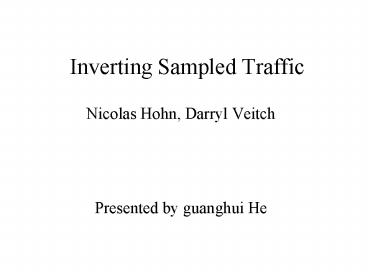Inverting Sampled Traffic PowerPoint PPT Presentation
1 / 24
Title: Inverting Sampled Traffic
1
Inverting Sampled Traffic
- Nicolas Hohn, Darryl Veitch
- Presented by guanghui He
2
Outline
- Introduction and preliminaries
- Objective
- Theoretical analysis
- Practical results
- Conclusion
3
Network measurement
- Proactive methods
- Single probing packet pair techniques
- Packet pair techniques
- Representatives pathchar, pathload, delphi,
pathchirp - Passive methods
- Network sampling packet level sampling and flow
level sampling
4
Sampling techniques
- Simple random sampling method each incoming
packet is sampled with prob. P - Systematic sampling
- Stratified random sampling
T
5
Two level of sampling in Internet traffic
- Packet level without considering which flow a
packet belongs to. Usually used to the measure
the volume of traffic (first order statistics) - Flow level sample the packets within a
particular flow. Usually used to find more
complicated statistics, i.e., the distribution of
packets within a flow, and can be used to further
identify elephants and mice. - Sometimes, these two techniques are combined
6
Objective of this paper
- How to obtain the spectral density (packet level)
of the traffic, which is second order statistics. - How to obtain the distribution of the number of
packets per flow (flow level). - Sampling method packet sampling and flow
sampling - In each sampling method, simple random sampling
technique is applied.
7
Theoretical analysis
- Theoretically, how to obtain power spectral
density and the distribution of the number of
packets per flow from packet sampling and flow
sampling? - Notations for a stationary point process X with
rate , each point of X is kept with prob. q,
so that the sampled process is a new point
process - with rate . Let
and denote the spectral density of
the thinned and original process respectively.
8
Packet sampling
- Existing result reads
- so with the knowledge of ,
can be easily obtained. - To derive the distribution of the number of
packets in each flow assume the original process
is the superposition of identically distributed
groups of points call clusters (flows). Let P
denote the discrete random variable representing
the number of points in each cluster with density
, distribution ,
mean
9
Packet sampling (cont.)
- Similar notations with superscript (q) denotes
those for the thinned point process. - Then, it is straightforward to get
- Let C(z,r), D(z,r) and denote the
circle, the open disk and the full disk with
center z and radius r. Let B be the binomial
random variable with parameter q. Let
be the prob. generating
function of P, and B
10
Packet sampling (cont.)
- Then we have
or, - and
- Theoretically, the probability of can be
obtained by picking out the coefficients of a
power series expansion of Gp about the origin.
But what we get is not defined over the entire
disk. - How to recover the original probability
densities?
11
How to recover?
12
Analytical continuation
- In principle, Gp is analytical in D(0,1) and we
know its values on D(1-q,q) which lies inside
D(0,1), then Gp is know on D(0,1) through
analytic continuation. - Denote and ,
then - Choose a point and to expend Gp as
a power series about it and the coefficient of
the new series can be obtained as
13
Analytical continuation (cont.)
- The coefficient of the new series
- Consider the case in the previous figure choose
, we have and - Now it works fine for , what if
qlt0.5?
14
Analytic continuation (cont.)
- A recursive procedure involving a sequence
- At the kth stage, is chosen to lie inside the
circle of convergence from the previous step, and
Gp will be expanded in a power series centered
about , and the coefficients can be obtained
from previous stage
15
An illustration
16
The second method
- Inverse transform based method given Gp(z), we
can use Cauchy integral formula, where s is
closed contour containing origin. - The problem is such kind of closed contour may
not exist. A common method is to use Pade
approximation.
17
Flow sampling
- The flow sampling consists in selecting flows
with probability q. - Since the flows are kept by the thinning
procedure are identically the same as the
original flow, there is no inversion problem for
the distribution of the number of packet per
flow. - How to get the spectral density of the original
process?
18
Flow sampling (cont.)
- Consider a special kind of stationary point
process X(t). Let the arrival times of
flows follow a given process Y(t) of rate .
Then the cluster process X(t) is defined as
, where
represents the arrival process of packets within
flow i. - Furthermore, Y(t) is assumed to be Poisson and
all flows are mutually independent.
19
Flow sampling (cont.)
- Let be the spectrum of , the
spectrum of X(t) can be shown to be - The i.i.d sampling with probability q of the
Poisson flow arrival process Y(t) with rate
is also a Poisson process with rate - .
- So
, and
20
Practical results spectral
21
Practical resultspectral (2)
22
Flow distribution (1)
23
Flow distribution (2)
24
Conclusions
- Packet sampling leads to an excellent
reconstruction of the spectrum and a fair
estimate the distribution of the number of packet
per flow for qgt0.5 - The flow sampling gives a reasonable estimate of
the spectrum and an excellent estimate of the
distribution of the number of packet per flow for
a larger range of thinning probabilities.

